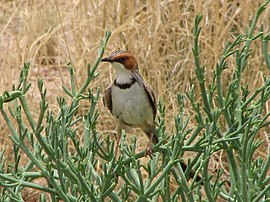en
names in breadcrumbs


The family Cisticolidae is a group of about 160 warblers, small passerine birds found mainly in warmer southern regions of the Old World. They were formerly included within the Old World warbler family Sylviidae.
This family probably originated in Africa, which has the majority of species, but there are representatives of the family across tropical Asia into Australasia, and one species, the zitting cisticola, breeds in Europe.
These are generally very small birds of drab brown or grey appearance found in open country such as grassland or scrub. They are often difficult to see and many species are similar in appearance, so the song is often the best identification guide. These are insectivorous birds which nest low in vegetation.
The family was introduced (as Cisticolinae) by the Swedish zoologist Carl Jakob Sundevall in 1872.[1][2]
Many taxonomists place the red-winged prinia and the red-fronted prinia in the genus Prinia rather than in their own monotypic genera.[3][4] Support for their placement in Prinia is provided by a molecular phylogenetic study of the Cisticolidae published in 2013 that found that both species were closely related to the prinias.[5]
The family contains 168 species divided into 26 genera:[6] For more detail, see List of Cisticolidae species.

The family Cisticolidae is a group of about 160 warblers, small passerine birds found mainly in warmer southern regions of the Old World. They were formerly included within the Old World warbler family Sylviidae.
This family probably originated in Africa, which has the majority of species, but there are representatives of the family across tropical Asia into Australasia, and one species, the zitting cisticola, breeds in Europe.
These are generally very small birds of drab brown or grey appearance found in open country such as grassland or scrub. They are often difficult to see and many species are similar in appearance, so the song is often the best identification guide. These are insectivorous birds which nest low in vegetation.